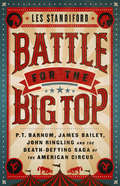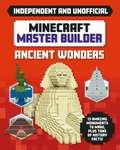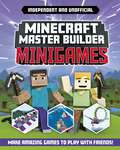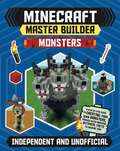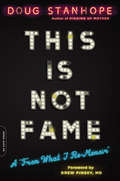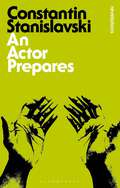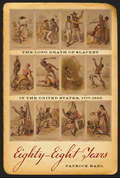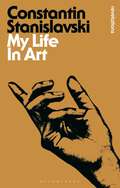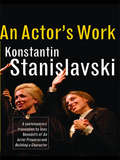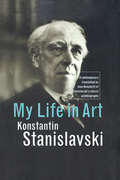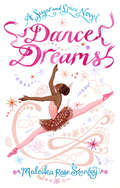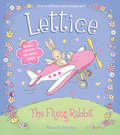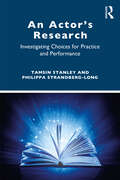- Table View
- List View
Battle for the Big Top: P.T. Barnum, James Bailey, John Ringling, and the Death-Defying Saga of the American Circus
by Les StandifordA New York Times bestselling author writes the untold story of three Golden Age titans and the confrontations, cutthroat business strategies, and eccentric personalities that built the Ringling Bros., Barnum & Bailey Circus. Millions have sat under the &“big top,&” watching as trapeze artists glide and clowns entertain, but few know the captivating stories behind the men whose creativity, ingenuity, and determination created one of our country&’s most beloved pastimes.In Battle for the Big Top, New York Times–bestselling author Les Standiford brings to life a remarkable era when three circus kings—James Bailey, P.T. Barnum, and John Ringling—all vied for control of the vastly profitable and influential American Circus. Ultimately, the rivalry of these three men resulted in the creation of an institution that would surpass all intentions and, for 147 years, hold a nation spellbound. Filled with details of their ever-evolving showmanship, business acumen, and personal magnetism, this Ragtime-like narrative will delight and enchant circus-lovers and anyone fascinated by the American experience.
A New History of Japanese Cinema
by Isolde StandishIn A New History of Japanese Cinema Isolde Standish focuses on the historical development of Japanese film. She details an industry and an art form shaped by the competing and merging forces of traditional culture and of economic and technological innovation. Adopting a thematic, exploratory approach, Standish links the concept of Japanese cinema as a system of communication with some of the central discourses of the twentieth century: modernism, nationalism, humanism, resistance, and gender. After an introduction outlining the earliest years of cinema in Japan, Standish demonstrates cinema's symbolic position in Japanese society in the 1930s - as both a metaphor and a motor of modernity. Moving into the late thirties and early forties, Standish analyses cinema's relationship with the state-focusing in particular on the war and occupation periods. The book's coverage of the post-occupation period looks at "romance" films in particular. Avant-garde directors came to the fore during the 1960s and early seventies, and their work is discussed in depth. The book concludes with an investigation of genre and gender in mainstream films of recent years. In grappling with Japanese film history and criticism, most western commentators have concentrated on offering interpretations of what have come to be considered "classic" films. A New History of Japanese Cinema takes a genuinely innovative approach to the subject, and should prove an essential resource for many years to come.
Politics, Porn and Protest: Japanese Avant-Garde Cinema in the 1960s and 1970s
by Isolde StandishOut of a background of war, occupation and the legacies of Japan's post-defeat politics there emerged a dissentient group of avant-garde filmmakers who created a counter-cinema that addressed a newly constituted, politically conscious audience. While there was no formal manifesto for this movement and the various key filmmakers of the period (Oshima Nagisa, Imamura Shohei, Yoshida Yoshishige, Hani Susumu, Wakamatsu Koji and Okamoto Kihachi) experimented with very different conceptions of visual style, it is possible to identify a sensibility that motivated many of these filmmakers: a generational consciousness based on political opposition that was intimately linked to the student movements of the 1950s, and shared experiences as Japan's first generation of post-war filmmakers artistically stifled by a monopolistic and hierarchal commercial studio system that had emerged reinvigorated in the wake of the 'red purges' of the late-1940s. Politics, Porn and Protest: Japanese Avant-Garde Cinema in the 1960s and 1970s provides a much needed overview of these filmmakers and reconsiders the question of dissent in the cultural landscape of Japan in the post-war period.
Politics, Porn and Protest: Japanese Avant-Garde Cinema in the 1960s and 1970s
by Isolde StandishOut of a background of war, occupation and the legacies of Japan's post-defeat politics there emerged a dissentient group of avant-garde filmmakers who created a counter-cinema that addressed a newly constituted, politically conscious audience. While there was no formal manifesto for this movement and the various key filmmakers of the period (Oshima Nagisa, Imamura Shohei, Yoshida Yoshishige, Hani Susumu, Wakamatsu Koji and Okamoto Kihachi) experimented with very different conceptions of visual style, it is possible to identify a sensibility that motivated many of these filmmakers: a generational consciousness based on political opposition that was intimately linked to the student movements of the 1950s, and shared experiences as Japan's first generation of post-war filmmakers artistically stifled by a monopolistic and hierarchal commercial studio system that had emerged reinvigorated in the wake of the 'red purges' of the late-1940s. Politics, Porn and Protest: Japanese Avant-Garde Cinema in the 1960s and 1970s provides a much needed overview of these filmmakers and reconsiders the question of dissent in the cultural landscape of Japan in the post-war period.
Master Builder - Minecraft Ancient Wonders: A Step-by-step Guide to Building Your Own Ancient Buildings, Packed With Amazing Historical Facts to Inspire You! (Master Builder)
by Sara StanfordThis fun, accessible guide is filled with detailed instructions on making fabulous ancient world structures in Minecraft. It includes 13 different structures from Ancient Greece, Egypt, China and the Americas, with everything from the Great Wall of China to the Colossus of Rhodes. There are even instructions for an epic build of Egypt's Great Pyramid of Giza and the Sphinx.Builds range in difficulty, so there's something for every reader to get creating right away. Plus, every section is filled with fun facts about each ancient culture, helping to turn historical information into amazing interactive play. It's perfect for anyone who wants to learn and create at the same time – or for anyone who just loves making the most awesome Minecraft builds.
Master Builder - Minecraft Minigames: Amazing Games to Make in Minecraft (Master Builder)
by Sara StanfordThis fun, accessible guide contains instructions on how to build and play 12 different minigames within Minecraft. It's fun, simple and perfect for anyone who plays Minecraft with buddies online.Have you ever wanted to race, quest or even play Battle Royale with friends in Minecraft? All it takes to make a cool minigame is some time, some blocks and an online friend or two! The games are designed to be made in regular Minecraft, with no mods or hacking needed. They range in difficulty from simple mazes to more complex race tracks and obstacle courses. Thanks to simple, clear instructions, building the games is as much fun as making them. There's also lots of information on how to get Minecraft multiplayer working, how to get your friends involved, and how to make sure you're playing safely.The minigames include archery practice, Battle Royale, obstacle courses, arenas, race courses, boating challenges, and even sky races.They're perfect for anyone who wants to play and create at the same time – or for anyone who loves playing Minecraft with friends.
Master Builder - Minecraft Monsters: A Step-by-Step Guide to Creating Your Own Monsters, Packed with Amazing Mythical Facts to Inspire You! (Master Builder)
by Sara StanfordMinecraft Master Builder: Monsters is a step-by-step player's guide to building griffins, yetis, minotaurs and many more monsters in Minecraft. Featuring everything from heraldic beasts to Norse and Greek mythical monsters, this fun and interactive guide will inspire readers to build amazing monstrous Minecraft models. Each build is rated a Quick, Intermediate, Master or Supreme Master Build, and a list of materials is provided for each project, plus guidance on how long each build will take. There's even information on all kinds of beasts from legend and folklore, including pictures, facts and mythology.
This Is Not Fame: A "From What I Re-Memoir"
by Doug StanhopeAn unfiltered, unapologetic, hilarious, and sometimes obscene assemblage of tales from the down-and-dirty traveling comedy circuit Doug Stanhope has been drunkenly stumbling down the back roads and dark alleys of stand-up comedy for over a quarter of a century, roads laden with dank bars, prostitutes, cheap drugs, farm animals, evil dwarfs, public nudity, menacing third-world police, psychotic breaks, sex offenders, and some understandable suicides. You know, just for levity. While other comedians were seeking fame, Stanhope was seeking immediate gratification, dark spectacle, or sometimes just his pants. Not to say he hasn't rubbed elbows with fame. He's crashed its party, snorted its coke, and jumped into its pool naked, literally and often repeatedly -- all while artfully dodging fame himself. Doug spares no legally permissible detail, and his stories couldn't be told any other way. They're weird, uncomfortable, gross, disturbing, and fucking funny.This Is Not Fame is by no means a story of overcoming a life of excess, immorality, and reckless buffoonery. It's an outright celebration of it. For Stanhope, the party goes on.
An Actor Prepares (Bloomsbury Revelations)
by Constantin StanislavskiAn Actor Prepares is the most famous acting training book ever to have been written and the work of Stanislavski has inspired generations of actors and trainers. This translation was the first to introduce Stanislavski's 'system' to the English speaking world and has stood the test of time in acting classes to this day. Stanislavski here deals with the inward preparation an actor must undergo in order to explore a role to the full. He introduces the concepts of the 'magic of' units and objectives, of emotion memory, of the super-objective and many more now famous rehearsal aids. An inspirational book presented in a drama class structure to ignite powerful performances.
Creating A Role: Improvisation And The Theatre (Bloomsbury Revelations)
by Constantin StanislavskiCreating A Role is the third book - alongside the international bestseller An Actor Prepares and Building A Character - in the series of influential translations that introduced Stanislavski's acting 'system' to the English-speaking world. Here Stanislavski describes the elaborate preparation that an actor must undergo before the actual performance itself. The book includes the director's analysis of such works as Othello and Gogol's Inspector General.
My Life In Art (Bloomsbury Revelations)
by Constantin StanislavskiNo one has had a greater influence on acting as we know it than Stanislavski. His 'method' - or interpretations of it - has become the central force determining almost every performance we see on stage or screen. In My Life in Art Stanislavski recalls his theatrical career, from his early experiences in Rubinstein's Russian Musical Society to his final triumphs with Chekhov at the Moscow Art Theatre. His vivid accounts of his own most famous productions including 'The Seagul' and 'Uncle Vanya' are interspersed with anecdotes of the famous - of Kommisarjevksy, Tolstoy, Gorky, and of the Moscow visit of Isadora Duncan and Gordon Craig.
My Life In Art (Bloomsbury Revelations)
by Constantin StanislavskiNo one has had a greater influence on acting as we know it than Stanislavski. His 'method' - or interpretations of it - has become the central force determining almost every performance we see on stage or screen. In My Life in Art Stanislavski recalls his theatrical career, from his early experiences in Rubinstein's Russian Musical Society to his final triumphs with Chekhov at the Moscow Art Theatre. His vivid accounts of his own most famous productions including 'The Seagul' and 'Uncle Vanya' are interspersed with anecdotes of the famous - of Kommisarjevksy, Tolstoy, Gorky, and of the Moscow visit of Isadora Duncan and Gordon Craig.
Stanislavski's Legacy
by Constantin StanislavskiFirst Published in 1987. Routledge is an imprint of Taylor & Francis, an informa company.
Stanislavski's Legacy
by Constantin StanislavskiFirst Published in 1987. Routledge is an imprint of Taylor & Francis, an informa company.
Creating A Role (Bloomsbury Revelations)
by Constantin Stanislavski John GillettCreating A Role is the third book - alongside the international bestseller An Actor Prepares and Building A Character - in the series of influential translations that introduced Stanislavski's acting 'system' to the English-speaking world. Here Stanislavski describes the elaborate preparation that an actor must undergo before the actual performance itself. The book includes the director's analysis of such works as Othello and Gogol's Inspector General.
An Actor's Work: A Student's Diary
by Konstantin StanislavskiStanislavski’s ‘system’ has dominated actor-training in the West since his writings were first translated into English in the 1920s and 30s. His systematic attempt to outline a psycho-physical technique for acting single-handedly revolutionized standards of acting in the theatre. Until now, readers and students have had to contend with inaccurate, misleading and difficult-to-read English-language versions. Some of the mistranslations have resulted in profound distortions in the way his system has been interpreted and taught. At last, Jean Benedetti has succeeded in translating Stanislavski’s huge manual into a lively, fascinating and accurate text in English. He has remained faithful to the author's original intentions, putting the two books previously known as An Actor Prepares and Building A Character back together into one volume, and in a colloquial and readable style for today's actors. The result is a major contribution to the theatre, and a service to one of the great innovators of the twentieth century.
An Actor's Work: A Student's Diary
by Konstantin StanislavskiStanislavski’s ‘system’ has dominated actor-training in the West since his writings were first translated into English in the 1920s and 30s. His systematic attempt to outline a psycho-physical technique for acting single-handedly revolutionized standards of acting in the theatre. Until now, readers and students have had to contend with inaccurate, misleading and difficult-to-read English-language versions. Some of the mistranslations have resulted in profound distortions in the way his system has been interpreted and taught. At last, Jean Benedetti has succeeded in translating Stanislavski’s huge manual into a lively, fascinating and accurate text in English. He has remained faithful to the author's original intentions, putting the two books previously known as An Actor Prepares and Building A Character back together into one volume, and in a colloquial and readable style for today's actors. The result is a major contribution to the theatre, and a service to one of the great innovators of the twentieth century.
My Life in Art
by Konstantin StanislavskiKonstantin Stanislavski was a Russian director who transformed theatre in the West with his contributions to the birth of Realist theatre and his unprecedented approach to teaching acting. He lived through extraordinary times and his unique contribution to the arts still endures in the twenty-first century. He established the Moscow Art Theatre in 1898 with, among other plays, the premiere of Chekhov's The Seagull. He also survived revolutions, lost his fortune, found wide fame in America, and lived in internal exile under Stalin's Soviet Union. Before writing his classic manual on acting, Stanislavski began writing an autobiography that he hoped would both chronicle his rich and tumultuous life and serve as a justification of his aesthetic philosophy. But when the project grew to 'impossible' lengths, his publisher (Little, Brown) insisted on many cuts and changes to keep it to its deadline and to a manageable length. The result was a version published in English in 1924, which Stanislavski hated and completely revised for a Soviet edition that came out in 1926. Now, for the first time, translator Jean Benedetti brings us Stanislavski's complete unabridged autobiography as the author himself wanted it – from the re-edited 1926 version. The text, in clear and lively English, is supplemented by a wealth of photos and illustrations, many previously unpublished.
My Life in Art
by Konstantin StanislavskiKonstantin Stanislavski was a Russian director who transformed theatre in the West with his contributions to the birth of Realist theatre and his unprecedented approach to teaching acting. He lived through extraordinary times and his unique contribution to the arts still endures in the twenty-first century. He established the Moscow Art Theatre in 1898 with, among other plays, the premiere of Chekhov's The Seagull. He also survived revolutions, lost his fortune, found wide fame in America, and lived in internal exile under Stalin's Soviet Union. Before writing his classic manual on acting, Stanislavski began writing an autobiography that he hoped would both chronicle his rich and tumultuous life and serve as a justification of his aesthetic philosophy. But when the project grew to 'impossible' lengths, his publisher (Little, Brown) insisted on many cuts and changes to keep it to its deadline and to a manageable length. The result was a version published in English in 1924, which Stanislavski hated and completely revised for a Soviet edition that came out in 1926. Now, for the first time, translator Jean Benedetti brings us Stanislavski's complete unabridged autobiography as the author himself wanted it – from the re-edited 1926 version. The text, in clear and lively English, is supplemented by a wealth of photos and illustrations, many previously unpublished.
Stanislavsky: A Life In Leters
by Konstantin Stanislavsky Laurence SenelickKonstantin Stanislavsky transformed theatre in the West and was indisputably one of the twentieth century’s greatest innovators. His life and work mark some of the most significant artistic and political milestones of that tumultuous century, from the emancipation of the serfs to the Russian Revolution. Little wonder, then, that his correspondence contains gripping exchanges with the famous and infamous of his day: men such as Tolstoy, Chekhov, Trotsky and Stalin, among others. Laurence Senelick, one of the world’s foremost scholars of Russian literature, mines the Moscow archives and the definitive Russian edition of Stanislavsky’s letters, to produce the fullest collection of the letters in any language other than Russian. He sheds new light on this fascinating field. Senelick takes us from the earliest extant letter of an eleven-year-old Konstantin in 1874, through his work as actor, director and actor trainer with the Moscow Art Theatre, to messages written just before his death in 1938 at the age of seventy-five. We discover Stanislavsky as son, brother and father, as lover and husband, as businessman and "internal emigre." He is seen as a wealthy tourist and an impoverished touring actor, a privileged subject of the Tsar and a harried victim of the Bolsheviks. Senelick shares key insights into Stanislavsky's work on such important productions as The Seagull, The Cherry Orchard, Hamlet, Othello, and The Marriage of Figaro. The letters also reveal the steps that led up to the publication of his writings My Life in Art and An Actor’s Work on Himself. This handsome edition is also comprehensively annotated and fully illustrated.
Directing for Stage and Screen
by J. Stanley M. MontaIf directing dramatic productions interests you, this book is a basic guide to show you know to apply the principles of directing to any dramatic medium - stage, television, or film. The authors, who have worked in all three media, illustrated how the principles of one medium relate to the other two.
Dance Dreams
by Malaika Rose StanleyWhen she receives a call-back from the amazing Birchwood School for Dance, thirteen-year-old Keisha is over the moon. She’s one pirouette closer to becoming a superstar ballerina!But getting a place at Birchwood would mean moving schools and leaving behind her BFFs – and the swoon-worthy Joel Daley-Clarke. Until she knows the outcome, Keisha must keep the biggest news of her life a secret from her best friends.Can she hold it together, or will her dance dreams turn into a nightmare?
The Flying Rabbit (Lettice)
by Mandy StanleyLettice is a little rabbit with big dreams! As Lettice hops around on the hill with her family she sees a little bird flying overhead, swooping and looping and then soaring away.'How wonderful it must be to fly,' Lettice thinks and from that moment she makes up her mind that somehow or other she will…
An Actor’s Research: Investigating Choices for Practice and Performance
by Tamsin Stanley Philippa Strandberg-LongAn Actor’s Research: Investigating Choices for Practice and Performance presents an accessible and highly practical guide to the research approaches required of the actor. It aims to establish the precision and rigour of the actor’s craft that is intrinsic to a compelling acting performance, explore a range of research activities surrounding and emerging from practical work in the studio, and enable the actor to evolve a multifaceted skillset in researching for performance. The chapters focus on different research areas such as the self, character, relationships, circumstance, and context, providing accessible and practical guidance to developing a personal research practice. Each aspect is explained and engaged with as practice, rather than study – offering helpful hints and advising against common pitfalls – ultimately enabling the actor to locate the necessary knowledge to shape and inform their performance in both text-based and devised scenarios. Additionally, as the actor’s self is a personal instrument that is drawn on in terms of expression, impulses, and imagination; the self also becomes a source for creative appraisal and research. This book therefore offers comprehensive advice and strategies for self-evaluation and reflection, connecting research investigation with self-exploration in making expressive performance choices, making it a practice highly applicable to the actor’s needs. An Actor’s Research closely follows the training actor’s needs in terms of performance-based research; however, its practical research activities for text and character creation and strategies for the development of critical thinking and self-reflective skills support the ongoing development of the actor and their craft in both training and professional circumstances.
An Actor’s Research: Investigating Choices for Practice and Performance
by Tamsin Stanley Philippa Strandberg-LongAn Actor’s Research: Investigating Choices for Practice and Performance presents an accessible and highly practical guide to the research approaches required of the actor. It aims to establish the precision and rigour of the actor’s craft that is intrinsic to a compelling acting performance, explore a range of research activities surrounding and emerging from practical work in the studio, and enable the actor to evolve a multifaceted skillset in researching for performance. The chapters focus on different research areas such as the self, character, relationships, circumstance, and context, providing accessible and practical guidance to developing a personal research practice. Each aspect is explained and engaged with as practice, rather than study – offering helpful hints and advising against common pitfalls – ultimately enabling the actor to locate the necessary knowledge to shape and inform their performance in both text-based and devised scenarios. Additionally, as the actor’s self is a personal instrument that is drawn on in terms of expression, impulses, and imagination; the self also becomes a source for creative appraisal and research. This book therefore offers comprehensive advice and strategies for self-evaluation and reflection, connecting research investigation with self-exploration in making expressive performance choices, making it a practice highly applicable to the actor’s needs. An Actor’s Research closely follows the training actor’s needs in terms of performance-based research; however, its practical research activities for text and character creation and strategies for the development of critical thinking and self-reflective skills support the ongoing development of the actor and their craft in both training and professional circumstances.
